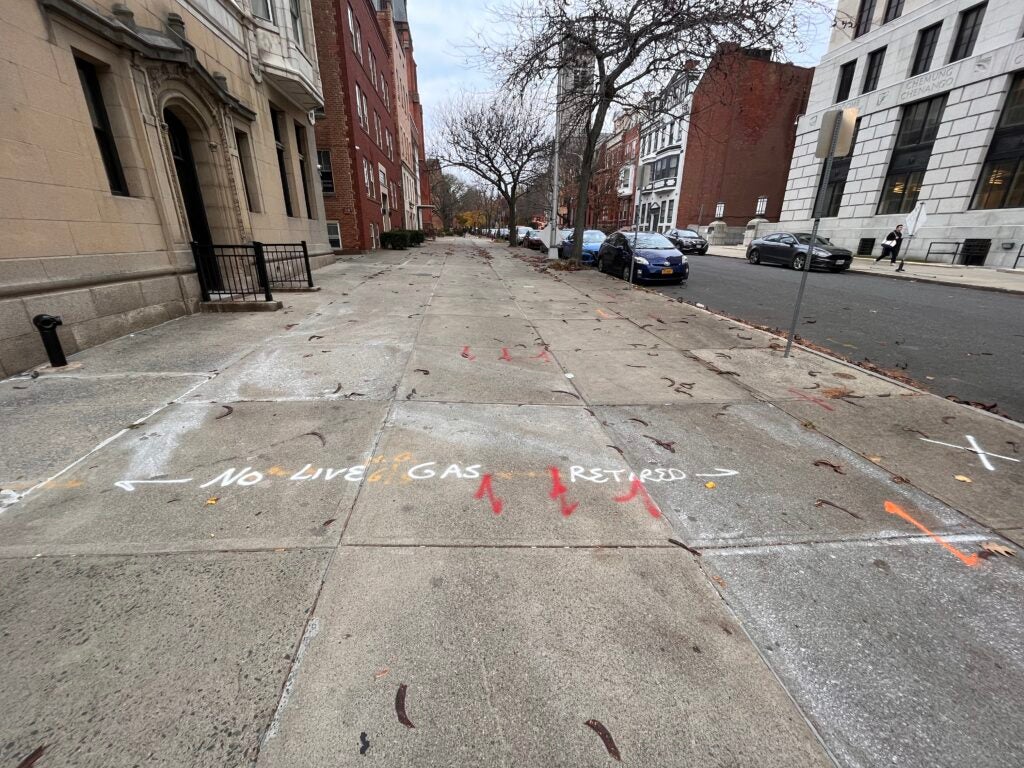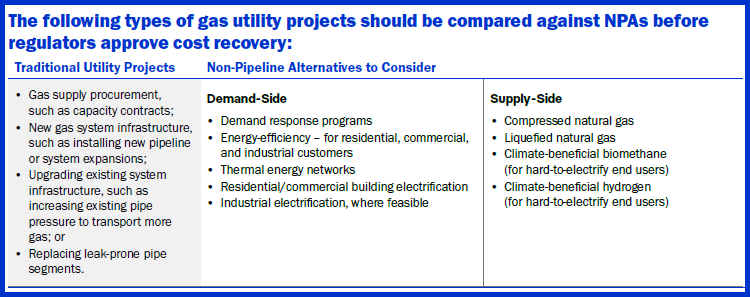By Magdalen Sullivan, Co-Authored by Erin Murphy
Many states are adopting declining emission limits as a way to address the severe and growing dangers of the climate crisis, and that means state utility regulators are grappling with how to decarbonize energy systems, manage costs and meet demand.
Traditional approaches to meeting energy demand with natural gas have included pipeline construction, pipeline replacement or large gas system upgrades — but these may no longer be appropriate investments in light of new policies and changing customer preferences.
EDF’s new report looks at non-pipeline alternatives to meet energy needs Share on XInstead, increasingly popular options are Non-Pipeline Alternatives, or NPAs. They are projects designed to meet energy demand without expensive infrastructure projects that run counter to state climate goals.
EDF has a new report, Non-Pipeline Alternatives: Meeting Energy Demand Responsibly, that has guidance and analysis to help states develop regulatory frameworks for NPA evaluation and implementation, and to help utilities successfully implement NPA programs.
Non-Pipeline Alternatives can reduce pollution and costs
Methane, the primary component of natural gas, is a potent climate pollutant with more than 80 times the 20-year warming power of carbon dioxide. The U.S. natural gas pipeline network is estimated to leak as much as 2.7 million tons of methane per year. The combustion of natural gas in buildings accounts for 13% of all U.S. climate pollution.
Effective utility planning that incorporates NPAs can reduce dangerous climate pollution by reducing reliance on natural gas, and by avoiding long-lived pipeline projects that may extend fossil fuel reliance.
Right now, gas utilities are continuing to expand their infrastructure. For instance, in Maryland, the state’s three biggest gas utilities are projected to spend a combined $6.3 billion on natural gas infrastructure development and replacement projects by 2043.
However, as residential customers access new electrification benefits through the Inflation Reduction Act and other programs, declining natural gas demand may shorten the useful life of pipelines and other assets. Ratepayers will then be stuck paying the cost of these investments (plus profit to the utility) over many decades, creating a risk of stranded assets.
Regulators can avoid exacerbating this issue by mandating NPA implementation where feasible. A variety of alternative solutions should be considered by utilities:
A roadmap for regulators
EDF’s new report finds that regulators should adopt clear and inclusive standards for consideration and implementation of NPAs. This can help meet near-term energy needs while facilitating a managed energy transition.
States and utilities should demonstrate leadership and innovation by adopting NPA processes that:
- Identify and quantify demand needs as early as possible.
- Consider NPAs for all supply, capacity and capital projects. Regulators and utilities should not establish cost or time thresholds that limit when NPAs are considered.
- Seek all possible solutions to meet demand or address infrastructure needs through solicitation of third-party proposals.
- Evaluate all costs and benefits of bids — including the climate and health benefits of avoiding a traditional gas infrastructure project.
- Keeps a robust record of the basis for the utility’s decision about the chosen solution.
- Ensure an open, equitable process by making information about the demand, options considered and basis for the chosen solution publicly available; requiring the consideration of impacts to disadvantaged communities when assessing projects and allowing for public participation during the NPA selection process.
- Make cost recovery contingent on proper solicitation and evaluation of NPAs. Only if an NPA is ultimately not suitable to meet the identified need should the utility proceed with a traditional gas supply solution.
New York: a case study in NPA implementation
Effective regulatory frameworks for NPA consideration can streamline how utilities identify, evaluate and implement solutions to meet demand. Several states, including Colorado, California and New York are moving forward with strong NPA policies, with varying success.
Here’s a look at what we found when we studied New York’s model:
The New York Public Utility Commission directed utilities to propose NPA screening and suitability criteria as part of a long-term gas planning proceeding. Though the Commission’s leadership on NPA prioritization is commendable, we also found the utilities’ proposals to be inappropriately narrow, excluding many opportunities to consider NPAs.
NPAs should be considered as an alternative to all traditional gas supply, capacity and capital projects. New York utilities, however, propose that all projects associated with “safety, reliability and service obligation” should be ineligible for NPA consideration. Of course urgent safety threats must always be addressed, but the utilities’ proposed exclusions would deny NPA consideration for potentially suitable projects.
New York’s utility proposals also propose that projects where construction would begin in less than 24 months should be ineligible for NPAs. But some system expansion projects, like connecting new customers to the system, can be relatively minor and quick to implement — and should still be considered for NPAs.
For instance, our analysis found that on average the National Fuel Gas Distribution Company completed expansion-related capital projects in 88 days and non-expansion capital projects in 179 days. (see our report, page 21) A two-year ineligibility threshold for NPA consideration is therefore inappropriately narrow. Unless the project is addressing an emergency or urgent safety concern, NPAs should always be considered when a utility is undertaking a facility expansion or replacement project.
In conclusion
At a time of rapid change in energy markets and policies, regulators and utilities should use every opportunity available to manage costs for ratepayers, avoid inappropriate investments and reduce greenhouse gas emissions. NPA’s are the path to meeting those goals.











